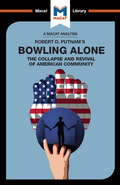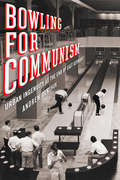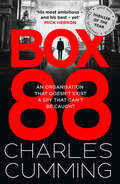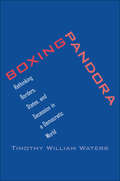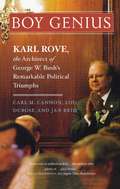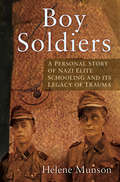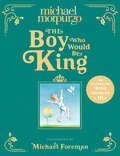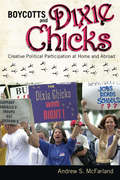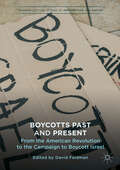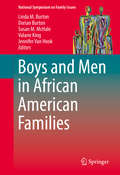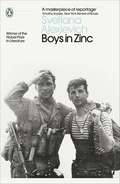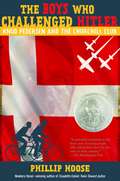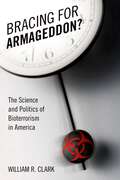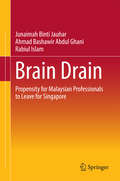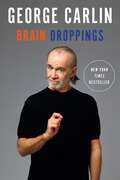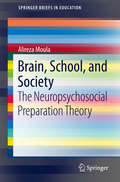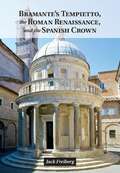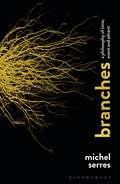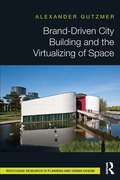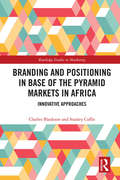- Table View
- List View
Bowling Alone (The Macat Library)
by Elizabeth Morrow Lindsay Scorgie-PorterAmerican political scientist Robert Putnam wasn’t the first person to recognize that social capital – the relationships between people that allow communities to function well – is the grease that oils the wheels of society. But by publishing Bowling Alone, he moved the debate from one primarily concerned with family and individual relationships one that studied the social capital generated by people’s engagement with the civic life. Putnam drew heavily on the critical thinking skill of interpretation in shaping his work. He took fresh looks at the meaning of evidence that other scholars had made too many assumptions about, and was scrupulous in clarifying what his evidence was really saying. He found that strong social capital has the power to boost health, lower unemployment, and improve life in major ways. As such, any decrease in civic engagement could create serious consequences for society. Putnam’s interpretation of these issues led him to the understanding that if America is to thrive, its citizens must connect.
Bowling for Communism: Urban Ingenuity at the End of East Germany
by Andrew DemshukBowling for Communism illuminates how civic life functioned in Leipzig, East Germany's second-largest city, on the eve of the 1989 revolution by exploring acts of "urban ingenuity" amid catastrophic urban decay. Andrew Demshuk profiles the creative activism of local communist officials who, with the help of scores of volunteers, constructed a palatial bowling alley without Berlin's knowledge or approval. In a city mired in disrepair, civic pride overcame resentment against a regime loathed for corruption, Stasi spies, and the Berlin Wall.Reconstructing such episodes through interviews and obscure archival materials, Demshuk shows how the public sphere functioned in Leipzig before the fall of communism. Hardly detached or inept, local officials worked around centralized failings to build a more humane city. And hardly disengaged, residents turned to black-market construction to patch up their surroundings.Because such "urban ingenuity" was premised on weakness in the centralized regime, the dystopian cityscape evolved from being merely a quotidian grievance to the backdrop for revolution. If, by their actions, officials were demonstrating that the regime was irrelevant, and if, in their own experiences, locals only attained basic repairs outside official channels, why should anyone have mourned the system when it was overthrown?
BOX 88 (BOX 88 #1)
by Charles CummingAn organisation that doesn’t exist. A spy that can’t be caught.
Boxing Pandora: Rethinking Borders, States, and Secession in a Democratic World
by Timothy William WatersA timely and provocative challenge to the foundations of our global order: why should national borders be unchangeable? The inviolability of national borders is an unquestioned pillar of the post–World War II international order. Fixed borders are believed to encourage stability, promote pluralism, and discourage nationalism and intolerance. But do they? What if fixed borders create more problems than they solve, and what if permitting borders to change would create more stability and produce more just societies? Legal scholar Timothy Waters examines this possibility, showing how we arrived at a system of rigidly bordered states and how the real danger to peace is not the desire of people to form new states but the capacity of existing states to resist that desire, even with violence. He proposes a practical, democratically legitimate alternative: a right of secession. With crises ongoing in the United Kingdom, Spain, Ukraine, Iraq, Syria, Sudan, and many other regions, this reassessment of the foundations of our international order is more relevant than ever.
Boy Genius: Karl Rove, the Architect of George W. Bush's Remarkable Political Triumphs
by Lou Dubose Jan Reid Carl M. CannonThe Washington Post Bestseller - Now Updated with Five New Chapters and a New Epilogue Unlike President George. W. Bush, Karl Rove, his chief political adviser, is rarely "misunderestimated." Many of the president's opponents see Rove's hand in everything the president does. His friends, and the president himself, are just thankful he's on their side, and always has been. From their earliest days in Texas, Rove saw and tapped the potential of George W. Bush. "Political hacks like me wait a lifetime for a guy like this to come along," Rove said of the future president. The authors of Boy Genius fill readers in on the man, his methods, and his plans for the Republican majority for a fascinating, entertaining look at the Man Who Would be Kingmaker, an investigation that debunks myths as it reveals facts, and the story of exactly how American politics works now. From allegations of bugging his own office back in Texas, to shadowy dealings with Swift Boat veterans in the last election, Rove has played politics all the way to the highest levels, and though it sometimes isn't pretty, it works.
Boy Soldiers: A Personal Story of Nazi Elite Schooling and its Legacy of Trauma
by Helene MunsonAt the end of the Second World War, hundreds of thousands of German children were sent to the front lines in the largest mobilisation of underage combatants by any country before or since. Hans Dunker was just one of these children. Identified as extremely gifted aged 9, he left his home in South America in 1937 in pursuit of a ‘proper’ education in Nazi Germany. Instead, he and his schoolfriends, lacking adequate training, ammunition and rations, were sent to the Eastern Front when the war was already lost in the spring of 1945. Using her father’s diary and other documents, Helene Munson traces Hans’ journey from a student at Feldafing School to a soldier fighting in Zawada, a village in present-day Czech Republic. What is revealed is an education system so inhumane that until recently, post-war Germany worked hard to keep it a secret. This is Hans’ story, but also the story of a whole generation of German children who silently carried the shame of what they suffered into old age. It reveals the true cost and long-lasting impacts of such experiences – not just to them, but also to their families and future generations, a warning to a world where thousands of child soldiers are still sent to fight in armed conflicts.
The Boy Who Would Be King
by Michael MorpurgoA beautifully illustrated full-colour tribute to King Charles III, published to mark his coronation – from the bestselling creators of There Once Is a Queen.
Boycotts and Dixie Chicks: Creative Political Participation at Home and Abroad
by Andrew S. McFarlandBoycotts and Dixie Chicks introduces the concept of 'creative political participation', collective political actions which do not use traditional methods and which are innovative, collaborative and creative in character. Andrew S. McFarland discusses creative participation on issues concerning the environment, political corruption, consumer rights, and transnational issues. He draws on specific examples including anti-corruption demonstrations in contemporary rural China, community action in 1890s Wisconsin, consumer boycotts of Shell Oil, ExxonMobil, the Nestle Corporation, and the Dixie Chicks music group, the 'colour revolutions' and transnational fair trade and transparency activism. Written in an engaging, everyday language and using a wide variety of sources and case studies, Boycotts and Dixie Chicks is highly recommended for students of alternative social and political movements and sociology.
Boycotts and Dixie Chicks: Creative Political Participation at Home and Abroad
by Andrew S. McFarlandBoycotts and Dixie Chicks introduces the concept of 'creative political participation', collective political actions which do not use traditional methods and which are innovative, collaborative and creative in character. Andrew S. McFarland discusses creative participation on issues concerning the environment, political corruption, consumer rights, and transnational issues. He draws on specific examples including anti-corruption demonstrations in contemporary rural China, community action in 1890s Wisconsin, consumer boycotts of Shell Oil, ExxonMobil, the Nestle Corporation, and the Dixie Chicks music group, the 'colour revolutions' and transnational fair trade and transparency activism. Written in an engaging, everyday language and using a wide variety of sources and case studies, Boycotts and Dixie Chicks is highly recommended for students of alternative social and political movements and sociology.
Boycotts Past and Present: From the American Revolution to the Campaign to Boycott Israel (Palgrave Critical Studies of Antisemitism and Racism)
by David FeldmanIn this book historians and social scientists examine boycotts from the eighteenth century to the present day. Employed in struggles against British rule in the American colonies, against racial discrimination in the United States during the Civil Rights movement, and Apartheid in South Africa, today it is Israel that is the focus of a campaign for Boycott, Divestment and Sanctions (BDS). Boycotts have featured in campaigns undertaken by labour, consumer and nationalist movements. Jews were the focus of some boycotts instigated by nationalist movements in Central and Eastern Europe and Jewish businesses were targeted by the National Socialist regime in Germany. In this collection, contributors explore the history of past boycott movements and examine the different narratives put forward by proponents and opponents of the current BDS movement directed against Israel: one which places the movement within a history of struggles for ‘human rights’; the other which regards BDS as the latest manifestation of an antisemitic tradition.
Boys and Men in African American Families (National Symposium on Family Issues #7)
by Linda M. Burton Dorian Burton Susan M. McHale Valarie King Jennifer Van HookThis important volume takes a life course approach in sharing empirical insights on the family experiences of African American males in socioeconomic and political contexts. Representing fields ranging from developmental psychology to public health and sociology to education, chapters identify challenges facing black men and boys in the U.S., as well as family and community sources of support and resilience. Survey findings and exemplar case studies illustrate stressors and risk factors uniquely affecting African American communities, and tailored prevention and intervention strategies are described at the personal, family, and societal levels. These interdisciplinary perspectives not only encourage additional research, but inspire the continued development of appropriate interventions, relevant practice, and equitable policy.Included in the coverage:• The adjustment and development of African American males: Conceptual frameworks and emerging research opportunities.• A trauma-informed approach to affirming the humanity of African American boys and supporting healthy transitions to manhood.• Humanizing developmental science to promote positive development of young men of color.• Families, prisoner reentry, and reintegration.• Safe spaces for vulnerability: New perspectives on African Americans who struggle to be good fathers.• They can’t breathe: Why neighborhoods matter for the health of African American men and boys.Promoting diversity in the research agenda to reflect a diverse population, Boys and Men in African American Families is an invaluable reference for research professionals particularly interested in sociology, public policy, anthropology, urban and rural studies, and African American studies. Survey and ethnographic studies of poverty, inequality, family processes, and child, adolescent, and adult health and development are featured.
Boys in Zinc (Penguin Modern Classics)
by Andrew Bromfield Svetlana AlexievichThe haunting history of the Soviet-Afghan War from the winner of the Nobel Prize in Literature 2015- A new translation based on the updated text - From 1979 to 1989 Soviet troops engaged in a devastating war in Afghanistan that claimed thousands of casualties on both sides. While the Soviet Union talked about a 'peace-keeping' mission, the dead were shipped back in sealed zinc coffins. Boys in Zinc presents the honest testimonies of soldiers, doctors and nurses, mothers, wives and siblings who describe the lasting effects of war. Weaving together their stories, Svetlana Alexievich shows us the truth of the Soviet-Afghan conflict: the killing and the beauty of small everyday moments, the shame of returned veterans, the worries of all those left behind. When it was first published in the USSR in 1991, Boys in Zinc sparked huge controversy for its unflinching, harrowing insight into the realities of war.
The Boys Who Challenged Hitler: Knud Pedersen And The Churchill Club
by Phillip HooseAt the outset of World War II, Denmark did not resist German occupation. Deeply ashamed of his nation's leaders, fifteen-year-old Knud Pedersen resolved with his brother and a handful of schoolmates to take action against the Nazis if the adults would not. Naming their secret club after the fiery British leader, the young patriots in the Churchill Club committed countless acts of sabotage, infuriating the Germans, who eventually had the boys tracked down and arrested. But their efforts were not in vain: the boys' exploits and eventual imprisonment helped spark a full-blown Danish resistance. Interweaving his own narrative with the recollections of Knud himself, The Boys Who Challenged Hitler is National Book Award winner Phillip Hoose's inspiring story of these young war heroes. This thoroughly-researched and documented book can be worked into multiple aspects of the common core curriculum.
Bracing for Armageddon?: The Science and Politics of Bioterrorism in America
by William R. ClarkSince September 11th, the threat of a bioterrorist attack--massive, lethal, and unpreventable--has hung in the air over America. Bracing for Armageddon? offers a vividly written primer for the general reader, shedding light on the science behind potential bioterrorist attacks and revealing what could happen, what is likely to happen, and what almost certainly will not happen. The story opens with a riveting account of a bioterrorism scenario commissioned by the U.S. government. Using this doomsday tableau as a springboard, Clark reviews a host of bioterrorist threats (from agroterrorism to a poisoning of the water supply) and examines not only the worst-case menace of genetically engineered pathogens, but also the lethal agents on the CDC's official bioterrorism list, including Smallpox, Anthrax, Plague, Botulism, and Ebola. His overview of attempted bioterrorist attacks to date--such as the failed Aum Shinrikyo attempts in 1995 in Japan and the Anthrax attack in the US following 9/11--bolstered by interviews with a range of experts--shows why virtually all of these attempts have failed. Indeed, he demonstrates that a successful bioterrorism attack is exceedingly unlikely, while a major flu epidemic (such as the deadly epidemic of 1918 that killed millions worldwide) is a virtual certainty. Given the long odds of a bioterrorist attack, Clark asks, has the more than $40 billion the United States has dedicated to the defense against bioterrorism really been well spent? Is it time to move on to other priorities? In contrast to the alarmist fears stoked by the popular media, William Clark here provides a reassuring overview of what we really need to worry about--and what we don't.
Brain Drain: Propensity for Malaysian Professionals to Leave for Singapore (Springerbriefs In Economics Ser.)
by Junaimah Binti Jauhar Ahmad Bashawir Abdul Ghani Rabiul IslamThis book focuses on skilled labour migration from Malaysia to Singapore. In this regard, it examines a number of variables such as Better Perks and Benefits, Quality of Work Life, Ease of Immigration Procedures, International Exposure, Greater Job Availability, and Social Networks, and how they influence the decisions of Malaysian accounting professionals.In doing so, the book elaborates on how this phenomenon is an indirect result of globalization, which is predominantly detrimental for developing countries such as Malaysia.The book also highlights the need for these experts in their home country, as Malaysia is currently striving to improve its economy in order to achieve high-income status by 2020.
Brain Droppings
by George CarlinSometimes, a little brain damage can help. A book of original humor pieces by beloved comic George Carlin. Filled with thoughts, musings, questions, lists, beliefs, curiosities, monologues, assertions, assumptions, and other verbal ordeals, Brain Droppings is infectiously funny. Also included are two timeless monologues, "A Place for Your Stuff" and "Baseball-Football." Readers will get an inside look into Carlin's mind, and they won't be disappointed by what they find: I buy stamps by mail. It works OK until I run out of stamps.What year did Jesus Christ think it was?A tree: first you chop it down, then you chop it up.Have you ever noticed the lawyer is always smiling more than the client?I put a dollar in one of those change machines. Nothing changed.If you ever have chicken at lunch and chicken at dinner, do you ever wonder if the two chickens knew each other? Carlin demolishes everyday values and yet leaves you laughing out loud.
Brain, School, and Society: The Neuropsychosocial Preparation Theory (SpringerBriefs in Education)
by Alireza MoulaThis book reports on a research program designed to construct the basics of a new type of literacy that teaches pupils social problem-solving at individual and collective levels. It is the first of a series of books about a chain of intervention research subprojects started in 2009 teaching pupils basic skills to make well-balanced decisions; to resolve conflicts in a nonviolent manner; and to develop good social relationships and responsibility, critical thinking, and other abilities which give children and young people the tools needed to pursue their options in life. According to the United Nations, there is no systematic program in schools that develops these capacities in pupils. This volume fills the gap by describing successful classroom interventions and by developing a framework for social problem-solving literacy as mandated by the United Nations Child Convention.
Branches: A Philosophy of Time, Event and Advent
by Michel SerresDespite being one of France's most enduring and popular philosophers, Branches is the first English translation of what has been identified as Michel Serres' key text on humanism. In attempting to reconcile humanity and nature, Serres examines how human history 'branches' off from its origin story. Using the metaphor of a branch springing from the stem and arguing that the branch's originality derives its format, Serres identifies dogmatic philosophy as the stem, while philosophy as the branch represents its inventive, shape-shifting, or interdisciplinary elements. In Branches, Serres provides a unique reading of the history of thought and removes the barriers between science, culture, art and religion. His fluency and this fluidity of subject matter combine here to make a book suitable for students of Continental philosophy, post-humanism, the medical humanities and philosophical science, while providing any reader with a wider understanding of the world in which they find themselves.
Branches: A Philosophy of Time, Event and Advent
by Michel SerresDespite being one of France's most enduring and popular philosophers, Branches is the first English translation of what has been identified as Michel Serres' key text on humanism. In attempting to reconcile humanity and nature, Serres examines how human history 'branches' off from its origin story. Using the metaphor of a branch springing from the stem and arguing that the branch's originality derives its format, Serres identifies dogmatic philosophy as the stem, while philosophy as the branch represents its inventive, shape-shifting, or interdisciplinary elements. In Branches, Serres provides a unique reading of the history of thought and removes the barriers between science, culture, art and religion. His fluency and this fluidity of subject matter combine here to make a book suitable for students of Continental philosophy, post-humanism, the medical humanities and philosophical science, while providing any reader with a wider understanding of the world in which they find themselves.
Brand-Driven City Building and the Virtualizing of Space
by Alexander GutzmerThis book is an investigation of the cultural phenomenon of branding and its transformational effects on the contemporary spatial – and urban – reality. It develops a novel understanding of the rationale behind the construction of large-scale architectural complexes that relate to corporate brands, and of its tremendous cultural effects. The author suggests that what we see today is the creation of "global mass ornaments", of a thorough ornamentalization of the entire globe. The origins of this are discussed with regard to examples of corporate brand-building from Europe and China (Autostadt Wolfsburg, BMW Welt Munich and Anting New Town). Additional cases are several simulated spaces in Berlin and the space-branding activities of companies like Apple or Prada. Theoretically, the author develops an innovative poststructuralist framework, combining ideas from Gilles Deleuze with the space philosophy of Peter Sloterdijk. He analyzes how the corporate redefinition of space makes the city enter into a mode of virtual urbanity. This idea leads to a notion of a "global urban" and, ultimately, the "global mass ornament". This concept of a global mass ornament is developed here with reference to Sloterdijk’s concept of a world of "spheres". The latter is used to understand the new mode of spatiality of mediatized spaces. The book makes the point that our world is involved in a process of mass ornamentalization that has only just begun. The concept of the global mass ornament is the first to come to grips with a culture in which branding is effectively changing the physiognomy of the earth. The global mass ornament is a banner for a cultural transformation that employs architecture, sign theory and mechanisms borrowed from traditional advertising and from social media, as well as social processes – and that we have yet to properly understand. This book is a significant step forward in this respect.
Brand-Driven City Building and the Virtualizing of Space
by Alexander GutzmerThis book is an investigation of the cultural phenomenon of branding and its transformational effects on the contemporary spatial – and urban – reality. It develops a novel understanding of the rationale behind the construction of large-scale architectural complexes that relate to corporate brands, and of its tremendous cultural effects. The author suggests that what we see today is the creation of "global mass ornaments", of a thorough ornamentalization of the entire globe. The origins of this are discussed with regard to examples of corporate brand-building from Europe and China (Autostadt Wolfsburg, BMW Welt Munich and Anting New Town). Additional cases are several simulated spaces in Berlin and the space-branding activities of companies like Apple or Prada. Theoretically, the author develops an innovative poststructuralist framework, combining ideas from Gilles Deleuze with the space philosophy of Peter Sloterdijk. He analyzes how the corporate redefinition of space makes the city enter into a mode of virtual urbanity. This idea leads to a notion of a "global urban" and, ultimately, the "global mass ornament". This concept of a global mass ornament is developed here with reference to Sloterdijk’s concept of a world of "spheres". The latter is used to understand the new mode of spatiality of mediatized spaces. The book makes the point that our world is involved in a process of mass ornamentalization that has only just begun. The concept of the global mass ornament is the first to come to grips with a culture in which branding is effectively changing the physiognomy of the earth. The global mass ornament is a banner for a cultural transformation that employs architecture, sign theory and mechanisms borrowed from traditional advertising and from social media, as well as social processes – and that we have yet to properly understand. This book is a significant step forward in this respect.
Branding and Positioning in Base of the Pyramid Markets in Africa: Innovative Approaches (Routledge Studies in Marketing)
by Charles Blankson Stanley CoffieBrand management to sustain corporate reputation and customer loyalty is essential for both multinationals and indigenous fi rms in Africa. This book provides a practical overview of country branding and positioning activities in Africa, based on a broad defi nition of base of the pyramid (BoP) marketing, which includes both goods and services, as well as business-to-business marketing, corporate branding, and country branding. The text highlights branding strategies that can be adopted in BoP markets, as well as marketing mix strategies appropriate for much of the continent. Taking into account the role of social networks, culture, and religion, the book explores avenues for developing and building competitive advantage, and how African countries can leverage country branding as part of the development process. The book is ideal for researchers, educators and advanced students in international marketing, management, and brand strategy who are interested in the unique branding characteristics of the African continent.
Branding and Positioning in Base of the Pyramid Markets in Africa: Innovative Approaches (Routledge Studies in Marketing)
by Charles Blankson Stanley CoffieBrand management to sustain corporate reputation and customer loyalty is essential for both multinationals and indigenous fi rms in Africa. This book provides a practical overview of country branding and positioning activities in Africa, based on a broad defi nition of base of the pyramid (BoP) marketing, which includes both goods and services, as well as business-to-business marketing, corporate branding, and country branding. The text highlights branding strategies that can be adopted in BoP markets, as well as marketing mix strategies appropriate for much of the continent. Taking into account the role of social networks, culture, and religion, the book explores avenues for developing and building competitive advantage, and how African countries can leverage country branding as part of the development process. The book is ideal for researchers, educators and advanced students in international marketing, management, and brand strategy who are interested in the unique branding characteristics of the African continent.
